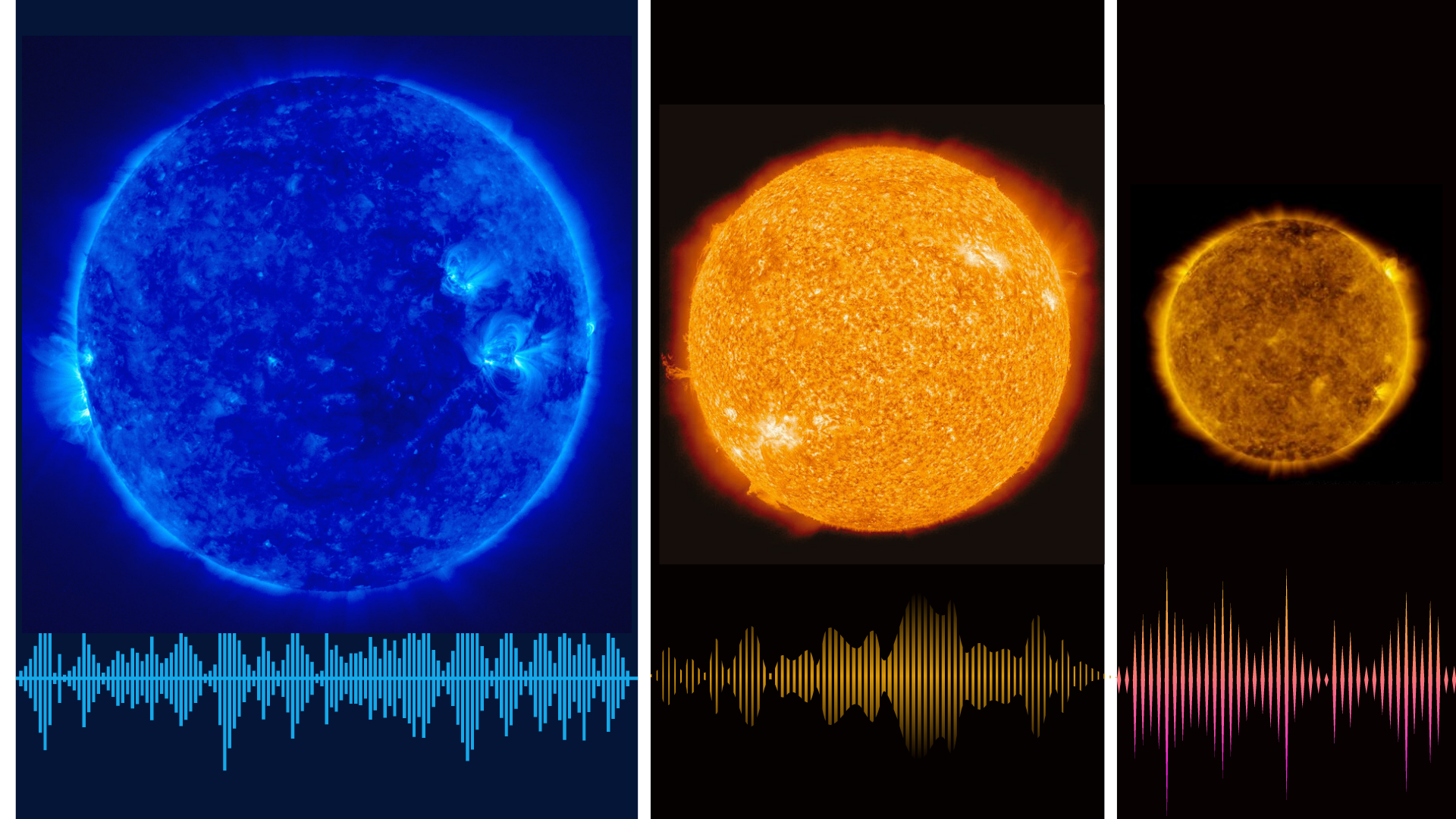Listen to the sound of 3 stars playing 'Twinkle Twinkle Little Star' (video)
With scientists measuring energy waves traveling through stars and setting them to music, the familiar tune takes on a whole new meaning.
Scientists created a 3D simulation of energy waves rippling through three separate stars, converted those ripples to sound waves, then set them to the familiar tune of "Twinkle Twinkle Little Star." This research should allow scientists to peer deeper into the interiors of stars than ever before.
Stars visually appear to twinkle from our vantage point on Earth due to the effects of the atmosphere, but stellar bodies also have an intrinsic "twinkle" associated with plasma rippling on their surfaces. The latter is imperceptible to even the most advanced telescopes on Earth.
In order to see this innate twinkle for the first time, researchers from Northwestern University created simulations of energy that ripples from nuclear furnaces sitting in the hearts of stars to their outer surfaces. And in converting those rippling plasma waves to sound waves, the team has enabled space enthusiasts to hear the eerie and fascinating songs created inside small, medium and large stars.
"Motions in the cores of stars launch waves like those on the ocean," study lead Evan Anders, a postdoctoral fellow at Northwestern's Center for Interdisciplinary Exploration and Research in Astrophysics (CIERA), said in a statement.
"When the waves arrive at the star's surface," Anders continued, "they make it twinkle in a way that astronomers may be able to observe. For the first time, we have developed computer models which allow us to determine how much a star should twinkle as a result of these waves. This work allows future space telescopes to probe the central regions where stars forge the elements we depend upon to live and breathe."
Related: Strange two-faced dying star 'Janus' baffles scientists in cosmic oddity
The chaotic orchestra within stars
Within every star lies a chaotic and disorderly region called the convection zone, where plasma churns and particles carry heat from the stellar core outwards to the body's upper layers. These particles then cool off and drop back closer toward the star's heart once again.
Breaking space news, the latest updates on rocket launches, skywatching events and more!
"Convection within stars is similar to the process that fuels thunderstorms," Anders said. "Cooled air drops, warms, and rises again. It’s a turbulent process that transports heat."
In massive stars, with masses around 1.2 times that of the sun, the convection zone is located at the stellar core — but regardless of this region's depth, it remains out of sight for astronomers. Waves created in the convection zone cause the light from stars to periodically dim and brighten, however, resulting in a subtle twinkle at the surface of a star.
Other waves generated in the convection zone get trapped and repeatedly bounce around within the stellar interior. To create simulations of those, the researchers also had to effectively "soundproof" the star.
"We first put a damping layer around the star — like the padded walls you would have in a recording studio — so we could measure exactly how the core convection makes waves," Anders said, comparing this to the padded walls of a music studio that minimize the acoustics.
Just like such padding allows music technicians on Earth to extract and easily manipulate pure sound, stellar soundproofing allowed Anders and colleagues to hone in on pure waves coming out of the convective zones of stars.
After tracking how those waves changed as they bounced around the interiors of the stars, the team was finally in a position to see how the waves would appear if they could be seen by powerful telescopes.
"Stars get a little brighter or a little dimmer depending on various things happening dynamically inside the star," Anders said. "The twinkling that these waves cause is extremely subtle, and our eyes are not sensitive enough to see it. But powerful future telescopes may be able to detect it."
Twinkle Twinkle... Little... Medium... Massive...Star
The team then took their sound studio inspiration further by converting the stellar plasma waves to sound waves. The resultant sound was outside the frequency range of human hearing, so the team also boosted the wave frequency to make the resulting song audible to us.
They discovered that, depending on the size and brightness of a star, the resultant sound changed. Sounds from the core of a massive star, for instance, were warped like the ray-gun noise from a 1950s sci-fi movie. But the sounds also continued to change as the waves hit the star’s surface layer.
For larger stars, the sound became more like an echo in an empty room. For medium stars, it shifted to resemble a persistent hum through a rainy landscape, and for small stars, waves reaching the surface sounded like a siren.
And finally, to make this effect less abstract, the team passed familiar music through the differently sized stars, including an audio clip from "Jupiter," a movement from "The Planets" orchestral suite by composer Gustav Holst and, of course, "Twinkle, Twinkle, Little Star." The result was the transformation of this familiar music to something suitably distant and haunting.
"We were curious how a song would sound if heard as propagated through a star," Anders concluded. "The stars change the music and, correspondingly, change how the waves would look if we saw them as twinkling on the star’s surface."
The team’s research is published in the July 27 edition of the journal Science.

Robert Lea is a science journalist in the U.K. whose articles have been published in Physics World, New Scientist, Astronomy Magazine, All About Space, Newsweek and ZME Science. He also writes about science communication for Elsevier and the European Journal of Physics. Rob holds a bachelor of science degree in physics and astronomy from the U.K.’s Open University. Follow him on Twitter @sciencef1rst.

